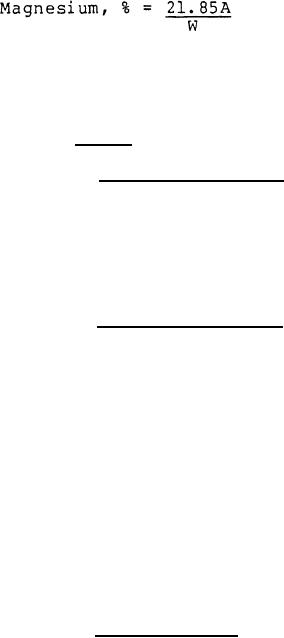 |
|||
|
|
|||
| ||||||||||
|
|  MIL-E-70610(AR)
Where:
A = Weight of precipitate (magnesium pyrophosphate)
W = Weight of sample
4.5.1.5 Boron.
Special ap paratus.
4.5.1.5.1
a. pH meter equipped with glass-calomel electrode system,
and calibrated with pH7 buffer.
b. Buret, 10 ml., graduated at 0.05 ml. intervals.
c. Hot plate, 11 watts per sq. in., Lindberg Type H-2, or
equivalent.
4.5.1.5.2
Special materials.
a. Barium hydroxide solution. Prepare by steeping 3 grams
of barium hydroxide octahydrate in a liter of water at least
overnight, then filtering through a Whatman No. 12, or equivalent,
folded paper.
b. Boric acid, standard solution containing 0.17 mg. of
boron per ml. Prepare by dissolving an accurately weighed 0.5 gram
portion of boric acid in 500 ml. of water.
c. Hydrochloric acid, lN solution.
d. Mixed acid. Prepare by stirring 33 ml. of 71%
perchloric acid into 12 ml. of water, and into this, stirring 55 ml.
of 96% sulfuric acid. This mixture must be permitted to cool before
use.
e. Potassium bichromate, 2% solution.
f. Sodium hydroxide, 2N solution, freshly prepared.
Accurately weigh a one (1) gram
4.5.1.5.3 Determination.
specimen into a 250 ml. erlemeyer flask with standard-taper joint
and insert an air-condenser. Through the condenser, add 1 ml. of
potassium dichromate solution and, slowly, 10 ml. of mixed acid.
Make similar additions to a sample free (blank) flask.
(Note 1
following this paragraph) Heat for a half hour at a reflux rate of
3-4 drops per minute (Note 2), then increase the temperature to a
rate of 10-15 drops per minute and hold at this temperature until
the color of the contents changes from green to orange. Remove the
flasks and let them cool to room temperature. Wash the condenser
walls and base with water and transfer the contents of the flask to
a 250 ml. volumetric flask. Add water to bring the volume to the
mark and shake to mix.
12
|
|
Privacy Statement - Press Release - Copyright Information. - Contact Us |